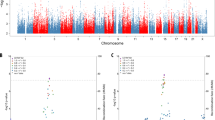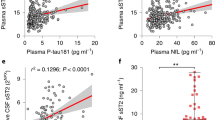Abstract
We have analyzed the 5′-upstream promoter region of the presenilin 2 gene (PSEN2) for regulatory elements and examined Alzheimer disease (AD) patients and non-demented individuals for polymorphisms in the 5′ upstream promoter region of the PSEN2 gene. Direct sequencing analysis detected a common single adenine (A) nucleotide deletion polymorphism in the upstream promoter region of the PSEN2 gene. Examination of cohorts of AD patients and age-matched control individuals revealed no statistically significant differences in the frequency of this polymorphism when compared with the total sample of AD patients and control individuals. However, subgroup and regression analysis suggested that the relatively rare −A/−A genotype increases risk of AD among subjects lacking apolipoprotein E (APOE) ε4 and among persons ages 65 years and younger. DNA sequence and DNA-protein binding analysis demonstrated that this mutation negates binding with putative repressor transcription factor (TF), interferon regulatory factor 2 (IRF2), in nuclear extracts prepared from the aged human brain neocortex. However this mutation creates a potential regulatory element, C/EBPbeta, that is responsive to pro-inflammatory (PI) induction. The expression activity assay with luciferase reporter gene into normal human neural progenitor cells in primary culture shows that the mutant PSEN2 regulatory region exhibits a 1.8-fold higher level of basal expression and is sensitive to IL−1β and Aβ42, but that it is synergistically induced 3.2-fold over the wild-type PSEN2 by [IL−1β+Aβ42]. These results suggest that under Pl and oxygen stress conditions relatively minor variations in PSEN2 promoter DNA sequence structure can enhance PSEN2 gene expression and that consequently these may play a role in the induction and/or proliferation of a Pl response in AD brain.
This is a preview of subscription content, access via your institution
Access options
Subscribe to this journal
Receive 12 print issues and online access
$259.00 per year
only $21.58 per issue
Buy this article
- Purchase on Springer Link
- Instant access to full article PDF
Prices may be subject to local taxes which are calculated during checkout




Similar content being viewed by others
References
Sherrington R, Rogaev EI, Liang Y, Rogaeva EA, Levesque G, Ikeda M et al. Cloning of a gene bearing missense mutations in early-onset familial AD Nature (London) 1995; 375: 754–760
Rogaev EI, Sherrington R, Rogaeva EA, Levesque G, Ikeda M, Liang Y et al. Familial AD in kindreds with missense mutations in a gene on chromosome 1 related to the AD type 3 gene Nature (London) 1995; 376: 775–778
Levi-Lahad E, Wasko W, Poorkaj P, Romano D, Oshima J, Pettingell W et al. A familial AD locus on chromosome 1 Science 1995; 269: 970–973
Cruts M, van Dujin C, Backhoven H, Van den B, Wehnert A, Serneels S et al. Estimation of the genetic contribution of presenilin-1 and -2 mutations in a population-based study of presenile AD Human Molec Genet 1998; 7: 43–51
Sherrington R, Floerich S, Sorbi S, Campion D, Chi H, Rogaeva E et al. AD associated with mutations in presenilin 2 is rare and variably penetrant Human Molec Genet 1996; 5: 985–988
Rogaeva EA, Fafel K, Song Y, Medeiros H, Sato C, Liang Y et al. Screening for PS1 mutations in a referral-based series of AD cases: 21 novel mutations Neurology 2001; 57: 621–625
The AD Collaborative group. The structure of the presenilin 1 (S182) gene and the identification of six novel mutations in early onset AD pedigrees Nat Genet 1995; 11: 219–222
AD forum www.alzforum.org
Rogaev EI, Sherrington R, Rogaeva E, Ikeda M, Levesque G, Lin C et al. Analysis of the 5′ sequence, genomic structure and alternative splicing of the presenilin 1 gene associated with early-onset AD Genomics 1997; 40: 415–424
Annaert W, Strooper B . Presenilins: molecular switches between protelysis and signal transduction Trends Neurosci 1999; 22: 439–442
Selkoe DJ . Notch and presenilins in vertebrates and inverebrates: implications for neuronal development and degeneration Curr Opin Neurobiol 2000; 10: 50–57
St George-Hyslop P . Molecular genetics of AD Seminal Neurol 1999; 19: 371–383
Yu G, Nishimura M, Arawaka S, Levitan D, Zhang L, Tandon A et al. Nicastrin modulates presenilin-mediated notch/glp-1 signal transduction and betaAPP processing Nature 2000; 407: 48–54
Rogaev EI . Presenilins: discovery and characterization of genes for AD Molec Biol 1998; 32: 58–69
Schutte M, Georgakopoulos A, Wen P, Robakis NK . Cellular localization of Presenilin 1 in the healthy and glaucomatous rat eye Invest Ophthalmol Vis Sci 2000; 41: S5051
Lukiw WJ, Bazan NG . Neuroinflammatory signaling upregulation in Alzheimer's disease Neurochem Res 2000; 25: 1173–1184
Hong CS, Caromile L, Nomata Y et al. Contrasting role of presenilin-1 and presenilin-2 in neuronal differentiation in vitro J Neurosci 1999; 19: 637–643
Lukiw WJ, Gordon WC, Rogaev EI, Thompson H, Bazan N . Presenilin-2 (PSEN2) expression upregulation in a model of retinopathy of prematurity and pathoangiogenesis NeuroReport 2001; 12: 53–57
Wang H, Qu X, De Plaen IG, Hsueh W . Platelet-activating factor and endotoxin activate CCAAT/enhancer binding protein in rat small intestine Br J Pharmacol 2001; 133: 713–721
van Duijin C, Cruts M, Theuns J, Van Gassen G, Bachoven H, van den Broeck M et al. Genetic association of the presenilin 1 regulatory region with early-onset AD in a population-based sample Eur J Hum Genet 1999; 7: 801–806
Theuns J, Del-Favero J, Dermut B, van Dujin C, Backhovens H, Van den Broeck M et al. Genetic variability in the regulatory region of presenilin 1 associated with risk for Alzheimer's disease and variable expression Human Molec Genetics 2001; 9: 325–331
Lambert J-C, Mann DM, Harris J, Chartier-Harlin M-C, Cumming A, Coates J et al. The -48 C/T polymorphism in the presenilin 1 promoter is associated with an increased risk of developing AD and an increased Abeta load in brain J Med Genet 2001; 38: 353–355
Rogaev E, Rogaeva E, Ginter E, Korovaitseva G, Farrer L, Shlensky A et al. Identification of the genetic locus for Keratosis Palmaris and Plantaris on chromosome 17 near the RARA and Keratin type 1 genes Nature Genet 1993; 5: 158–162
Rogaev E, Lukiw W, Vaula G, Haines J, Rogaeva E, Tsuda T et al. Analysis of the c-Fos gene on chromosome 14 and its relationships to the 5′-promoter of the amyloid precursor protein (APP) gene on chr 21 in familial AD Neurology 1993; 43: 2275–2279
Levy-Lahad E, Poorkaj P, Wang K, Fu Y, Oshima J, Milligan J, Schellenberg G . Genomic structure and expression of STR2, the chromosome 1 familial AD gene Genomics 1996; 34: 198–204
World Health Organization. International Classification of Diseases ICD-10; 10th edn 1990
McKhann G, Drachman D, Folstein M, Katzman R, Price D, Stadlan E . Clinical diagnosis of AD: report of the NINCDS-ADRDA work group under the auspices of the Department of Health and Human Services Task Force on Alzheimer's Disease Neurology 1984; 34: 939–945
Farrer L, Sherbatich T, Keryanov S, Korovaitseva G, Rogaeva E, Petruk S et al. Association between angiotensin-converting enzyme and AD Arch Neurol 2000; 57: 210–214
Korovaitseva G, Bukina A, Farrer L, Rogaev E . Presenilin polymorphisms in AD Lancet 1997; 350: 958–959
Lukiw WJ, Pelaez RP, Martinez J, Bazan NG . Budesonide epimer R or dexamethasone selectively inhibit platelet-activating factor-induced or interleukin 1 beta-induced DNA binding activity of cis-acting transcription factors and cyclooxygenase-2 gene expression in human epidermal keratinocytes Proc Natl Acad Sci USA 1998; 95: 3914–3919
Tanaka N, Kawakami T, Taniguchi T . Recognition DNA sequences of interferon regulatory factor 1 (IRF-1) and IRF-2, regulators of cell growth and the interferon system Mol Cell Biol 1993; 13: 4531–4538
Hardy J . The Alzheimer's family of diseases: many etiologies, one pathogenesis? Proc Natl Acad Sci USA 1997; 94: 2095–2097
Wrag M, Hutton M, Talbot C et al. Genetic association between intronic polymorphism in presenilin-1 gene and late-onset AD. AD Collaborative Group Lancet 1996; 347: 509–512
Scott WK, Yamaoka L, Locke P et al. No association or linkage between an intronic polymorphism of presenilin 1 and sporadic and late-onset familial AD Genet Epidemiol 1997; 14: 307–315
Struhl G, Greenwald I . Presenilin is required for activity and nuclear access of notch in drosophila Nature 1999; 398: 522–525
Cao X, Sudhov TC . A transcriptively active complex of APP with Fe65 and Histone Acetyltransferase Tip60 Science 2001; 293: 115–120
Refolo L, Eckman C, Parada CM, Yager D, Younkin S . Antisense reduction of presenilin 1 significantly increases Aβ42(43) secreted by human embrionic kidney cells Neurobiol Aging 1998; 19: S63
Acknowledgements
This work was supported by grants from the Howard Hughes Medical Institute, INTAS, European Commission Inco-Copernicus, Russian Fund for Basic Research, Russian Home Genome Program, NIH FIRCA, NIH AG18031, NIH AG09029, NIH AG95004, NIH NS23002, the Fogarty Center at NIH, and the EENT Foundation of Louisiana. Authors would like to thank to SI Gavrilova, N Selezneva, V Golimbet, A Lujnikova for assistance in collection of specimens of AD patients and elderly control subjects and I Chumakov for assistance in screening for 5′-regions of presenilins.
Author information
Authors and Affiliations
Corresponding author
Rights and permissions
About this article
Cite this article
Riazanskaia, N., Lukiw, W., Grigorenko, A. et al. Regulatory region variability in the human presenilin-2 (PSEN2) gene: potential contribution to the gene activity and risk for AD. Mol Psychiatry 7, 891–898 (2002). https://doi.org/10.1038/sj.mp.4001101
Received:
Revised:
Accepted:
Published:
Issue Date:
DOI: https://doi.org/10.1038/sj.mp.4001101
Keywords
This article is cited by
-
Transcriptome analysis reveals long intergenic non-coding RNAs involved in skeletal muscle growth and development in pig
Scientific Reports (2017)
-
Regulation of Neurotropic Signaling by the Inducible, NF-kB-Sensitive miRNA-125b in Alzheimer's Disease (AD) and in Primary Human Neuronal-Glial (HNG) Cells
Molecular Neurobiology (2014)
-
Evidence for induction of the ornithine transcarbamylase expression in Alzheimer's disease
Molecular Psychiatry (2009)
-
Two polymorphisms of presenilin-2 gene (PSEN2) 5′ regulatory region are not associated with Alzheimer’s disease (AD) in the Polish population
Journal of Neural Transmission (2008)
-
Polymorphisms in the 5′-untranslated region of the human serotonin receptor 1B (HTR1B) gene affect gene expression
Molecular Psychiatry (2003)



